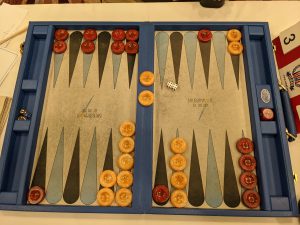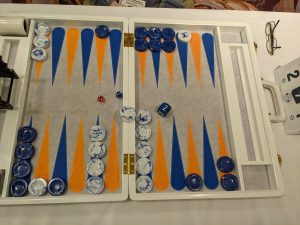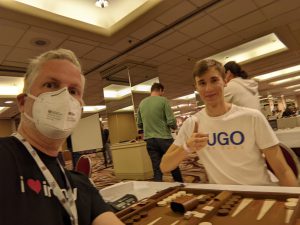I had the pleasure of attending the California State Championship tournament this past weekend, for 4 days of backgammon! The event is a quick two-hour flight away, and I know the organizers put on a good event from my prior experience at the LA Open pre-pandemic. I am glad I went!
I flew down Thursday morning for a short-lived run at the Dingwell amateur jackpot. I got exactly one match in that event, and spent the rest of the day playing a mix of Blitzes (5-point, 8 person brackets, in which I lost every time in round 1), DMPs (1-point matches, in which I was mysteriously unbeatable), and the “Juniors” event (for those of us under age 60).
Friday the main event started. I drew a match against April in round 1, which intimidated me because I know she’s been studying and rising in the ranks. However, I got very lucky off a possibly bad cube decision she made and came from behind to win. April went and re-entered, and went on to win the Consolation bracket. That meant I had a break until after dinner, and I used it to nap and walk and generally recharge the mental batteries. That night, I played my second round against Kevin, who trounced me, and then went on to win the overall event. The structure was a double elimination, so I still had a chance at winning the whole thing (although I did not, no suspense needed here). I played a few more rounds until I got to the just-before-the-money round.
So here’s a bit about hedging. I like to hedge. When you get to a point where the winner is guaranteed to cash and the loser is guaranteed nothing, most people are happy to set up a hedge, whereby the loser gets some share of the minimum payout.
I lost the game, but got the hedge. Then in the Consolation bracket, I also got to the just-before-the-money round, hedged again, and lost, but got the second hedge. Between the two, I ended up with more money than the 5th place payout that had been the basis for the first hedge!
So then there were the side events. In the DMP, they ran them as 4 separate entry brackets with a playoff. I ended up winning two brackets, and so got a bye in the playoff, but I had to fight for it. One director had said I got the bye, but a different one said it was a random draw, which would have given me a shot at winning both 1st and 2nd. But I knew I was going to hedge up to half of the prize anyway, so it made more sense to me to push for the bye, and that’s the way it went. When it came to the final, versus Patrick, we agreed to split the prize money evenly and just play for the trophy. The one other event I cashed in was a “Super Speed Gammon”, 5 point matches with a 30 second (!) time bank plus 8 second delay. I had just heard “Speed Gammon”, which is normally 2 minute time bank, and I’ve done those before – they’re a little stressful but fun. Well, 30 seconds is not a lot! I made it to the semi-final of that, but by then the other semi-finalist had already left for their flight home, and so we ended up with a split win on that one. Again, I paid out a hedge to my final opponent. So: 4 hedged events, split evenly between paying and getting paid.
I took pictures of a few positions through the weekend to analyze later, and a couple of people have promised me transcriptions of the matches they recorded. Here’s a couple of places where I blundered…
This first one is from the “Juniors” event. This is the Crawford game, with me leading 6-3 in the match to 7. I’ve got two on the bar and the situation is dire, but a lucky 44 roll put me back in the game:

The first two are easy: B/21(2). Then what? I can just keep going – B/17 (2); or I can un-stack either the 6-point or the 8-point. Or, for completeness, I could bring two down with 13/9(2), or I could switch with 5/1*(2); but I ruled both of those out immediately. Coming down leaves the back checkers badly disconnected, the switching play sets me up for a fight I probably lose as I am likely to leave a blot on the next roll after the hit. Ultimately I went with the 6/2(2), as that’s the heaviest stack. But XG says that coming out B/17(2) is the best move! 8/4(2) would have been a minor error, getting the strongest possible 3-point board to balance his 4-point board; but 6/2(2) was a -0.108 blunder! There’s something I do not understand about this one. If it was a cash game, 6/2(2) rises to second best, only a -0.022 error. At some point, I’ll go back and play from this position a few times, see if I can figure it out. Or something else will become my new confusing position and I’ll forget about it… one of the two.
This next one is a take/pass decision from the game that knocked me out of the main bracket. It’s a 7 point match, and I trail 2 to 1. Ignore the dice, we were using a baffle box and they’re just left over from my prior roll:

I’m on the bar, sure, but with 3 points to enter and him having three checkers back, I’m likely to enter/anchor. The thing which scared me was the gammon potential – he has 1’s plus 62, 64, 44 to hit the other blot in my outfield, and 55 to hit/cover the blot on his home board – 17 fairly devastating numbers! I figured it was a take for money (correct), but was too scared to take it. Roughly a -0.2 blunder!
Finally, a random selfie I took with Zdenek “ZZ” Zizka before our match in the “Juniors” match. This is the same ZZ who is at the top of the ranks on backgammon galaxy, and who gave the backgammon lecture the day before based on his new book. I lost the first game with the cube up to 4 (I had doubled too early, and taken a borderline recube – when you’re massively outclassed, it is good strategy to go for a shorter match where luck can help you out), but then fought my way back to get to 6-6 post-Crawford. At that point I felt a momentary surge of confidence, as I had beaten ZZ in a DMP game back on Thursday. Alas, that was not a feat I could recreate. Still, a fair showing against a very strong player…

Overall, a very enjoyable weekend of backgammon, and an easy event to get to for all us West Coast players…